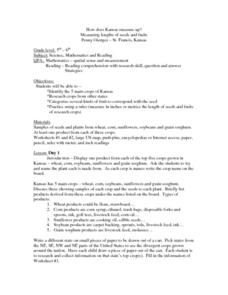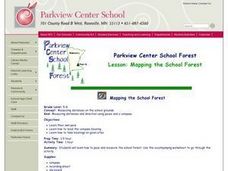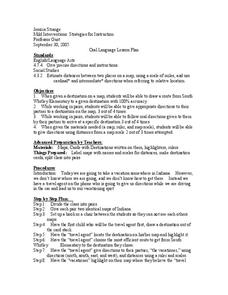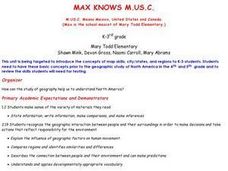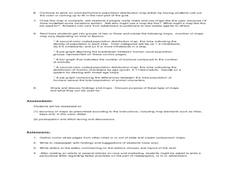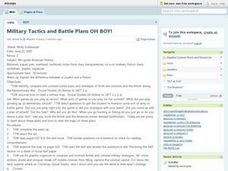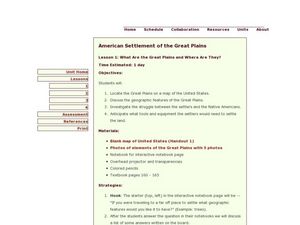Curated OER
How Does Kansas Measure Up?
Students identify the five main crops of Kansas and crops that are produced in other states. The categorize the types of fruits and seeds of each plant and measure each to compare the length of each.
Curated OER
At Your Fingertips
First graders observe a variety of different foods including kiwi, banbnas, coffee, chocolate and discuss where they come from. They discuss the terms import and export then identify the locations where the items came from and their...
Curated OER
Com-Post With Us? Learn About Recycling While Having Fun
Students examine the importance of recycling to help the environment. In groups, they make a compost bin on the school grounds recording how the material changes from week to week. They collect other materials for recycling like cell...
Curated OER
Paleogeographic Mapping (o.k. Fossils Are Neat But What Good Are They?)
Students examine how evidence from fossils can be used in paleogeographic interpretation. They gain experience in developing multiple hypotheses.
Curated OER
MAPPING THE SCHOOL FOREST
Young scholars measure distances and directions using paces and a compass. They determine their own pace, explore how to read a compass bearing, and how to take bearings on given sites.
Curated OER
What's Driving Us?
Middle schoolers determine what the people in their community are driving. Using traffic flow information, they develop recommendations on how to achieve sustainability. They calculate the carbon dioxide emission index for various sites...
Curated OER
Canada - US: Approaches to Immigration
Sixth graders explore the Canadian immigration experience through comparison and contrast to American immigration and settlement patterns. In this immigration patterns lesson, 6th graders dialogue their opinions regarding immigration....
Curated OER
International Trafficking of Women to the US
Learners develop an understanding of the problems of the illegal international trafficking of women into the U.S. They locate nations where trafficking originates. They explain their solutions to the problem in short essay format.
Curated OER
Using Literature to Introduce the Five Themes of Geography
Students listen to a read aloud of "If You Grew Up With Abraham Lincoln". Using the text, they identify examples of the five themes of geography and write them down. Using a map, they plot the places mentioned in the book and sort facts...
Curated OER
Oral Language
Students use distances on a map to draw a route, give directions, and follow directions. In this map lesson plan, students explain their route and directions orally.
Curated OER
The 50 States
Fifth graders use maps and music to learn the 50 states. In this US Geography lesson, 5th graders map out a region of the United States and practice singing the song, The 50 States that Rhyme.
Curated OER
Social Studies: Great Circle Route
Students compare routes between Minnesota and China using a map and globe. Using the "great circle route" method, students find the shortest route between two points.
Curated OER
Max Knows Mexicao, United States and Canada
Students utilize their map skills to explore the regions of North America. They explore the physical characteristics and climates of the regions. Students label their map and prepare a presentation of their findings.
Curated OER
Glaciers of Canada
Students examine photos, a poster, maps and an article series by National Geographic to determine characteristics of glaciers and the process of glaciation. They both answer guided questions and develop their own questions about the...
Curated OER
The Great Continental Drift Mystery
Students stud the concept of Pangaea by using Wegener's clues to construct a map of the continents joined together. They determine how fossil distribution can be used to enhance the study of continental drift. They locate the...
Curated OER
Joseph Had a Little Overcoat Lesson Plan
Young scholars discuss various features of a book, aspects of the story, and then engage in a retelling of the story. In this early childhood lesson plan, students identify the author, illustrator, and title of a book, Joseph Had a...
Curated OER
The Plains Indians
Students have a better understanding of another culture other than their own. This help them to see that there were other people living in this region before us.
Curated OER
What is the Population Distribution of Cartoon Characters Living On the Pages of Your Newspaper?
Students read various cartoons in their local newspaper and calculate the population demographics, spatial distribution and grouping of the characters. Using this information, they create a population distribution map and share them with...
Curated OER
Climate Patterns across the United States
Students articulate differences between climate and weather using examples in a written statement. Using climate data from across the country, they describe climate patterns for various parts of the United States on a map. Students...
Curated OER
Military Tactics and Battle Plans Oh Boy!
Eighth graders compare and contrast a Loyalist and a Patriot. After reading selected pages in the book, 8th graders use a graphic organizer to examine the battle plans of the colonists and the British during the Revolutionary War. They...
Curated OER
Regions of the United States
Students explore the regions of the United States. In this geography lesson plan, students read the text When I Was Young in the Mountains and compare the setting of the story with their geographical setting. Students use a physical map...
Curated OER
Geological Forces and Topography
Students discuss and research the Earth's geological processes. In this geology lesson, students study maps of Utah and the United States to learn about geological features. Students then complete the research cards for each area of...
Curated OER
Four Main Directions
Students describe directions using a globe for north, east, south and west. In this mapping activity students identify the north and south pole. Students understand the importance of the equator and the Prime Meridian. Students explain...
Curated OER
American Settlement of the Great Plains
Seventh graders examine the Great Plains. In this American settlement lesson, 7th graders create a map of the settled areas in the United States. Students discuss the struggle between settlers and the Native Americans.
Other popular searches
- Us Map 13 Colonies
- Using a Map Key
- Using a Map Scale
- Ussr Blank Map
- Us Map
- Map Uses
- Ussr Map
- Us Imperialism Map Activity
- Using Map Scales
- Using Map Scale Distance
- Us Map Skills
- Usa Geography Map Skills


